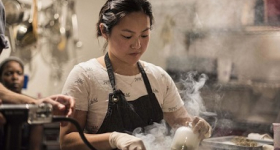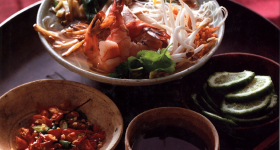My friend and I were getting lunch from a local Indian restaurant. Surrounded by the mouth‑watering aromas of curries and chutneys, we made pleasantries as we waited for our food. To make conversation, I asked her if her school-aged daughter liked Indian food. My friend’s response was, “No. She likes regular food.” While I internally processed this statement and all that it implied, our food arrived. As with so much restaurant fare nowadays, the plates were large and heaped with entrees and sides. As we gazed at our food and exclaimed about the portion sizes, my friend smiled at me and blithely said, “Well, you’re Asian. You can eat a lot and not gain weight.” And with those two comments, she encapsulated how food and culture affect what it means to be Asian American.
I am second-generation Chinese American and my friend is White American. Her comments were not designed to be hurtful or insensitive, but they reinforced ideas about Asian Americans and food that are rarely addressed in mainstream media or social science research. As a licensed clinical psychologist, I often work with clients around their physical sense of self and how their identity relates to how they choose to nourish themselves, at both a physical and emotional level. Exploring the prevalent narratives around Asian Americans and food is a way to understand some of the nuances and complexity within this population.
The relationship between Asian Americans and food is an integral part of an ongoing, dynamic narrative that contributes to how Asian American identity is shaped. Several factors mediate Asian Americans’ relationship with food, although these often are not illuminated beyond conventional wisdom within our communities. The messages that we are exposed to about the importance of food within Asian culture and internalized images of physical attractiveness contribute to assessing and understanding Asian American identity. These messages exist within an American milieu that still sees Asian food as foreign, much as my friend voiced to me. Indeed, Asian food, in all of its diversity and complexity, is not often considered “American” food, despite the fact that Chinese restaurants, for example, are more prevalent in the United States than McDonald’s. Trying to reconcile these conflicting elements often manifests in emotional struggles around physical self-concept. In other words, how we feel about and see ourselves physically is affected not only by what we consume, but how we feel about what we consume. To fully explore this terrain, we need to consider how we have felt or been made to feel about the food we eat, which requires us to explore food in a broad cultural and sociological context.
Food is necessary for life and important to cultures throughout the world. One traditional Chinese salutation is voiced by asking if a person has eaten yet. While it is not clear where such a greeting originated, one thought is that it was rooted in past times when people did not have enough to eat. So, asking whether or not someone had a meal was a demonstrable way to connect and care about them. This entwining of food and relationships extends further than a simple social acknowledgement. Seeing a relative and greeting them might result in direct comments on weight gain or loss, as well as one’s overall appearance. Such pointed mention of one’s physical appearance stands in sharp contrast to American culture, where talking with someone, particularly about weight gain, would be seen as a serious breach of social norms.
For Asian Americans, it can be difficult to reconcile these divergent messages. Our culture’s emphasis on food, family and community would perhaps be a strong buffer against pressure to be thin. However, many Asian American clients — women, in particular — talk of the pressure that they have felt directly from family members to look a certain way. Harkening back to my friend’s words, there is often a sense that Asians can eat a lot and yet remain slender. This idea is replicated in numerous Reddit or Quora threads that explore such topics as, “How come most Asian girls eat so much yet stay so skinny?” or “If carbs make you fat, then why are East Asians so skinny, considering they eat so much rice?” There are the more pointed comparisons: “You’re fat. Asians aren’t. Here’s why.” as well as, “Everyone in Japan is thin and beautiful (and so can you! [sic]).”
When I talk with other Asian Americans, particularly those from an older generation, I often hear statements echoing what my White American friend said. The other day, I was talking with an older Asian American, who reacted with some astonishment to the idea that this population could possibly struggle with eating disorders or body dysmorphia. Historically, eating disorders were seen as an issue affecting only affluent White American women, evoking that old American maxim, “You can never be too rich or too thin.” And while there have been significant changes through the years in American society, there is still awareness of how Whiteness and an hourglass shape for women and a muscular physique for men often define what is considered attractive.
In my experience as a psychologist, psychological research and mental health professionals need to better consider the impact of race and culture so that we expand beyond the traditional definition of body dysmorphia. Dysmorphia — or even body dissatisfaction, which would not be clinically defined as a mental disorder — is often discussed with only a passing mention of how culture might affect one’s physical sense of self. Yet such grounding in culture is necessary, given that research has demonstrated that when Asian American women are asked what physical features they wish they could change, they often cite eye shape and size, nose shape and cheek fat. They also mention breast size and wanting to be taller. When queried, Asian American men describe wanting to change the same facial features that women do, while also focusing on musculature and height. It is worth noting that all of these physical characteristics are the very ones that arguably most distinguish Asian bodies from White bodies, who often, even in this day and age, still often represent the standard for what is considered beautiful. In my clinical practice, I have never encountered an Asian American client struggling with body image issues who did not also bemoan some of the racialized features described above. When Asian American clients start talking about physical characteristics, there is almost always an explicit racial qualification of those features; for example, “I’m tall for an Asian,” or “I have big eyes for an Asian.” Therefore, to not assess or inquire about a client’s physical sense of self without situating such a discussion within a racialized context is to overlook a crucial aspect of Asian American identity (and this would extend to other racial minorities, as well).
Asian American clients often painfully discuss the interplay of how media images affect their sense of self and how they struggle to measure up to an unreachable physical standard. While this image may feel unattainable regardless of an individual’s cultural background, there is a particular sense of isolation in feeling that one’s race is the precluding factor in being able to achieve the ideal. It can be particularly poignant to bear witness to Asian Americans when they talk about feeling that they cannot measure up to the ideal and when those messages are partially reinforced by what they have heard from family or within the culture. Asian American women, in particular, talk about how female family members might shame them if their weight goes above a certain number, present them with a “gift” of plastic surgery in their teen years to give them double eyelids or narrow their nose, or slather them in skin whitening creams or potions.
But in the 25 years I’ve been engaged in this work, I can see things are changing, not only with clients, but in the media. Social media, particularly Instagram, is a force that is helping democratize attractiveness by giving a platform to the body positivity movement, where traditional notions of what constitutes good looks are met and countered directly and forcefully. The body positivity movement can also encompass discussion around issues of food and culture as they relate to body shape and size. Other media outlets have provided venues for people to speak about food and its direct connection to identity and culture, like award-winning chef David Chang. His current Netflix original series Ugly Delicious, which he created and produced, depicts him examining different foods and unpacking their cultural and sociological histories. In interviews about the show, he talks clearly about how food is a universal gateway to our emotions, family and cultural identity; these themes resonate and are articulated throughout each episode. David Chang does not speak about body image directly, but by having open discussions about food and culture, we can better understand and engage in conversations about our bodies as they are influenced by historical and cultural experiences.
The media can also issue a somber reminder that not all Asians and Asian Americans are surrounded by great quantities of food. For example, only in 2006 did the United States Department of Agriculture introduce language to describe the range of food insecurity in this country. Despite the prevalence of this issue in the mainstream media, data regarding Asian Americans dealing with this trauma garner scant attention. Yet from North Korean hunger to Asian immigrants living below the poverty line and dealing with food insecurity, it is imperative to remember the diversity within Asian America to have a truly inclusive understanding of these complex issues. Without such a balanced perspective, Asian Americans are rendered invisible and can be viewed — as they so often are — as a “model minority,” a population who suffers few if any social ills. Only through disaggregation and recognizing the diversity within Asian America can we truly gain a more accurate view of this heterogeneous group. I am further reminded of this when I sit with Asian American clients who detail how not having enough food when they were younger manifests itself in their current day awareness of not only their physical hunger and satiety but is tied inextricably to their emotional sense of deprivation, craving and fullness.
I ate my lunch at that Indian restaurant and talked with my friend about a variety of innocuous topics while snippets of the points above flashed through my mind. Internally, I debated about whether or not to address her comments. In the end, I decided not to, partly out of a culturally‑mediated sense of not wanting her to lose face by confronting her directly. But I know that this is a dialogue we need to have for our friendship to continue, and that versions of this discussion need to be had beyond the dyad at our table. Only by speaking up and unpacking the complexity of such topics can we hope to further the needed conversations both within and outside of our Asian American communities.










Comments